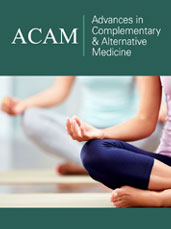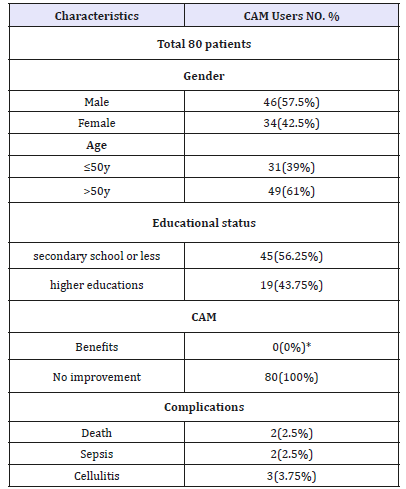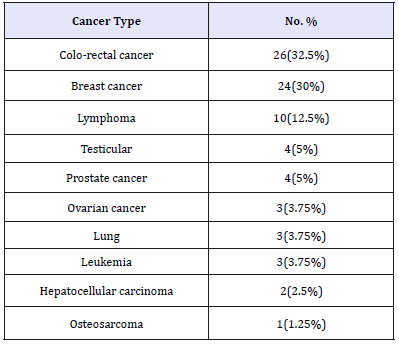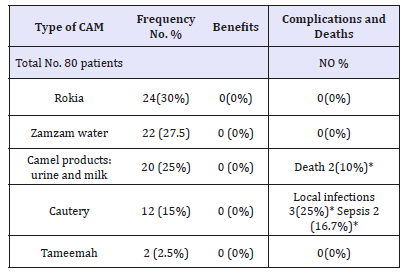- Submissions

Full Text
Advances in Complementary & Alternative medicine
Type of Complementary and Alternative Medicine Among Cancer Patients and its Complications: Local Experience
Ali Amril AM1, Jafar AR1*, Mustafa A1, Alhayek Q1, Almulaify MD1, Alhomran H1, Alkadhem SM1, Alshabeb H1, Albaker W1, Qrain AA1, Alshehri MA1 and Al Turki A2
1 Department of Internal Medicine/Oncology, Saudi Arabia
2 Department of Pediatrics, Saudi Arabia
*Corresponding author: Jafar AR, Department of Internal Medicine/Oncology, Saudi Arabia
Submission: February 04, 2019;Published: February 08, 2019

ISSN: 2637-7802 Volume4 Issue1
Abstract
Background: In our hospital, cancer patients are exposed to complementary and alternative medicine (CAM) in order to cure their cancer or to heal the symptoms. However, sometime these remedies end with complications or death. The aim of this study is to explore the benefits, and complications of CAM among Saudi cancer patients in our region.
Patients and methods: A cross-sectional, observational questionnaire-based study that included Saudi cancer patients treated with complementary medicine attending at our hospital from 2010 to 2018.
Results: A total of 80 cancer patients participated in this study. The most prominent type of CAM is Rokia, 30% followed with drinking of Zamzam water, 26.83%. Fortunately, these two types of CAM had no complications. Drinking Camel products was reported by 25% of cancer patients. This type of remedy had led to deaths of two cancer patients. Cautery use was reported by 15% of cancer patients and had led to local infection (cellulitis) at the Cautery site in 3 users and 2 cancer patients had succumb to sepsis. No benefits were clearly documented by our patients.
Conclusion: In this study, CAM usage has no beneficial effects; some can be very harmful for cancer patients including morbidity and mortality. These findings call for the urgent need for further in-depth study of CAM products to explore their beneficial effects and point out their complications.
Keywords: Cancer; Rokia; Cautery; Tameemah; Zamzam water; Camel milk; CAM
Abbreviations: DM: Diabetes Mellitus; IFN-γ: Interferon-Gamma; IL-1: Interleukin-1; IL-2: Interleukin-2; T2DM: Type 2 Diabetes Mellitus; WHO: World Health Organization
High Light of the Study
A. Five types of complenentary and alternative medicine were explored in this study.
B. The therapuetic outcome of this study has showed no benefits of compementary and alternative medicine in cancer patients.
C. This study has showed serious morbidity and mortality secondary to this kind of CAM
Introduction
Cancer is one of the major devastating diseases that associated with depression; loss of hope and feeling of imminent death. Cancer patients; therefore; do their best to find a way to cure their malignant disease and alleviate their symptoms. One of cancer patient’s options of therapy is complementary and alternative medicine (CAM). CAM refers to a wide range of products and ritual practices that are used by cancer patients alone or in conjunction with conventional therapy [1,2]. Complementary medicine is defined as therapy that complement the standard treatment or given in conjunction with it [2]. The alternative therapy is defined as therapy that used instead of the standard therapy [2].
CAM used by our cancer patients included: Rokia: It is an Arabic term which refers to wholly book words recited on an area of the body with blowing air from the healer mouth; Zamzam water is the blessed water from Zamzam well in Makkah; Camels milk and Camels urine: religious belief that drinking of Camels milk and/ or urine is curative medicine; Cautery: it is an instrument used to destroy abnormal tissues by burning; and Tameemah: (Amulets) It is a paper with wholly written text or drawings which is worn on the necks or hands of patients in order to get rid of evil and cure the cancer. The most important concerns about these types of CAM are side effects including morbidity and mortality either when they are used alone or along with the standard treatment of malignant disease. In addition; the lack of regulatory control and guidelines raises serious concerns about CAM usage [1,3,4]. This study; therefore; focuses on types of CAM and evaluation of outcome of these kinds of therapies in our cancer patients.
Material and Methods
An observational cross-sectional design was used in order to explore the benefits and complications of CAM usage. Information was collected from cancer patients; family members and charts of the patients. The ethical approval for this study was obtained from the IRB committee of the Imam Abdulrahman Bin Faisal University.
The questionnaire
Table 1:Patients characteristic.

*Benefit is defined by the patient own term and simplified by the question: did you think you benefited of the CAM therapy.
For the purpose of this study; the authors reconstructed a questionnaire regarding demographic characteristics of patients; type of cancer; and types of CAM; benefits and complications of these remedies. The questionnaire consisted of three main parts. The first was basic demographic data; including gender; age; educational level; diagnosis of cancer as shown in Table 1. The second concerned the type of cancer as reported in Table 2. The third part of the questions were directed to the type of CAM; definition of CAM and specific benefits and complications of CAM as shown in Table 3. Complications were confirmed by examination of the patients or from reviewing the patient’s charts at our hospital.
Table 2:Types of cancer.

Table 3:Types of CAM used by cancer patients and complications.

*Complications relative to the specific type of CAM.
Participants
The cancer patients or cancer patients with their family members attending at King Fahad Hospital of the university at Al- Khobar were recruited in this study. Charts and investigations were reviewed to confirm CAM complications or benefits at our hospital. Data of 80 cancer patients who have used CAM in addition to the standard medical therapy were included in this study as shown in Table 1.
Data collections
Cancer patients who met the inclusion criteria during the study period were invited to participate. Aim and information about the research was explained verbally to each respondent and consent was sought before the participation by trained medical students. Data also were collected from physicians and nurses relative to cancer patients. All participants responded verbally to the questions asked by the interviewers.
Data Analysis
Data that obtained from the questionnaire or found in the charts of patients were studied and analyzed by using simple statistics and calculations.
Results
A total of 80 cancer patients were interviewed and their charts were reviewed as well. Majority of patients were male 56.5%; 50 years old and above were 61.25%. More than half of patients received at least secondary level education 56.25% and 0% reported benefits of CAM while 100% reported no clear evidence that CAM improve their malignant disease or alleviate their symptoms. About 18% of all CAM users reported complications; cautery ulcer infections 11.25%; sepsis 6.25% and unfortunately 2.5% died secondary to Camel products complications Table 1. Three quarter of patients had colo-rectal cancer; breast cancer or lymphoma as shown in Table 2. Rokia users were 30% and none of these cancer patients reported benefits or developed complications secondary to this type of CAM. Zamzam water users were 26.83% and reported 0% benefits and reported no side effects. Camel products users were 25%; they reported no benefits or cure of their cancer; but unfortunately, 20% of Camel products users either developed sepsis or have died. Tameemah users were 2.5% only and reported no benefits and no complications as shown in Table 3.
References
To our knowledge; the current findings are the first to report the benefits and complications of CAM use among Saudi patients with cancer. The term complementary and alternative medicine (CAM) refers to a group of traditional products and religious practices that are may or may not include with the standard therapy [5-7]. In Saudi Arabia; the use of CAM is common and particularly growing among patients suffering of malignant diseases [8].
Forms of CAM used
In evaluating types of CAM modalities used by our cancer patients; we found five kinds of CAM used by our cancer patients including: Rokia; Zamzam water; Camel products; Cautery and Tameemah. All of these CAM forms are available at our community without prescription or medical supervision. With help of our cancer patients and their family members; each of the above form of CAM is defined accordingly.
Rokia
It is a religious term referring to a traditional therapy in which words of wholly book of Quran is recited many times on the site of painful area or diseased organ with blowing air from the mouth of the healer on the affected part of the body of the patients.
Zamzam water
It is water which coming from Zamzam well in Makkah as per request of cancer patients.
Camel’s products
Products of Camels included milk and some patients said this milk should be from young Camel; which mean after the 1st delivery of the Camel. The other product is urine. Some patients consumed pure milk; milk mixed with urine or pure urine. These types of products were given to the patients by Camel farmers upon request of cancer patients.
Cautery
Type of cautery; there were 2 types of cautery observed in our cancer patients. One type is cauterizing the lump itself with small piece of steel with one or multiple cauterization (burn) that affected the whole layer of skin and sometimes deeper to the subcutaneous tissues. The other type was many small superficial cauterizations with special character and distribution on the cancer patient’s body. All cauterization were carried outside hospital; either at the home of cancer patients or at the home of the healer.
Tameemah (Amulets)
It is a paper with wholly written text or drawings which is worn on the necks or hands of patients in order to get rid of evil and cure the cancer.
Benefits of CAM
As mentioned above; there were five forms of CAM. The majority of our patients reported that they were not under the supervision of their physicians while using CAM beside their standard medical therapy. All of our cancer patients have said that the reasons for using CAM were to cure their malignant disease. However; none of our cancer patients who used these five forms of CAM beside the standard therapy of cancer reported any clear clinical benefits. Benefit is defined by the patient own term and simplified by the question: did you think you benefit of the CAM therapy or not. To the best of our knowledge; there is no single study has proved any clear clinical benefits in regard to cancer outcome. One study has reported that there was no significant association between CAM use and QOL [9]. Two studies were investigated the therapeutic effects of camel milk on cancer of mice but showed preliminary and unclear effects [10,11]. So far; there is no enough data about CAM therapy regarding their clinical benefits and curative value in treating malignant diseases.
Complications of CAM
Patients suffering of cancer belief that CAM are natural; safe; holistic and harmless. However; there is evidence that some CAM is toxic and not free from harm. Therefore; high-quality clinical trials and researches are needed to clarify potential therapeutic effects and adverse outcome of CAM [12-14]. In this study; we found three forms of CAM are free of side effects. These forms are: Rokia; Zamzam water and Tameemah were benign type of CAM; since none of our cancer patients has reported complications related to such kind of CAM. Therefore; these three forms of CAM treatments did not clearly cause harm to our cancer patients. Usage of CAM may lead to unpredictable outcome because of the amount of the natural products used; duration of therapy; contamination; or interaction with other medication will affect the final outcome. There are many studies has reported concerns regarding direct or indirect adverse events of CAM [15-19].
Our study confirms that CAM is not devoid of risk. To our knowledge; this study is the first attempt to explore the potential harmful effects of specific form of CAM used by cancer patients in our region. Twelve patients (15%) of all cancer patients were treated with Cauterization and none of them reported any benefits of such burning therapy. Unfortunately; 25% has developed cellulitis secondary to these burns and 16.7% succumb to sepsis. However; all of them were treated with antibiotics and have recovered without complications. One study has reported that 7% of their Saudi patients used cautery as an alternative medicine but complications of such remedy was not reported and reported that such type of alternative medicine is not mentioned in the western studies [20].
In our study; we found 20 patients with cancer have used either Camel milk; Camel milk mixed with urine or Camel pure urine. All type of this CAM was provided by Camel shepherds. There was no medical supervision. Out of the twenty patients; 2 (10%) of them ended with death. One patient was diagnosed with primary cancer of unknown origin. She was discharged from the hospital well and on arrival at home at 8 PM she was given Camel milk mixed with urine as therapy for her cancer. Unfortunately; the relatives found her semi-comatose in the morning. She was brought to the hospital in drowsy state and she was died after about 3 weeks of admission. It was noticed that BUN was more than 100mg/dl and never decreased until she died. The other patient is female with advanced breast cancer.
She was treated with Camel milk and urine. She had nausea; abdominal pain; fever and diarrhea. She had succumbed to organ failure and death. Delay of conventional therapy; infection of brucellosis and death secondary to drinking raw Camel products have been reported in Saudi Arabia [8,21,22]. Camel products may be beneficial. However; without medical supervision to ensure safe administration can lead to very harmful outcome including not least brucellosis and Middle East respiratory syndrome coronavirus. Risks associated with Camel products can be lethal in immune-compromised patients especially patients suffering from cancer [22].
Despite the paucity of scientific evidence for the medical effectiveness of CAM; many cancer patients use CAM and most of these patients are not aware of the potential risk and complications of such remedies. There is no convincing evidence yet that any CAM is effective as therapy of cancer but can end with complications and death. CAM; by definition; consists of methods of traditional medicine that either has not been proved by clinical trials as standard therapy but with greater risk of complications and death [23-26].
CAM is variable with different ingredients and the general belief that CAM are harmless and useful is not realistic and these natural products should undergo safe exploration and clinical trials to find if they are innocent and have potential benefits in treating cancer.
Limitation of the Study
Our study; like any other; suffers from a number of limitations including bias toward CAM and the participant responses may be affected by interviewer bias. The sample size is small and spans over 10 years which can create response of bias and generalizability. However; this study was based on face-to-face interview with patients and their family members and supported by retrospective evaluation of patients’ chart. This study gives an idea on different and important aspects of Complementary and Alternative Medicine use among patients with cancer.
Summary
The utilization of CAM by cancer patients in our study is not beneficial and actually it was harmful. There is an urgent need to promote research in the field of CAM to address each form of CAM individually. In the absence of controlled clinical trials proving the safety and efficacy on the use of these forms of CAM by cancer patients remain theoretical.
Conflict of Interest
The authors declared that they have no potential conflicts of interest regarding this research.
References
- Oyunchimeg B, Hwang JH, Ahmed M, Choi S, Han D (2017). Complementary and alternative medicine use among patients with cancer in Mongolia: A national hospital survey. BMC Complement Altern Med 17(1): 58.
- Adams M, Jewell AP (2007) The use of complementary and alternative medicine by cancer patients. Int Semin Surg Oncol. 30(4): 10.
- Seely D, Oneschuk D (2008) Interactions of natural health products with biomedical cancer treatments. Curr Oncol 15(Suppl 2): 81-86.
- Bernstein J, Stibich M, LeBaron S (2002) Use of traditional medicine in Mongolia: A survey. Complement Ther Med 10(1): 42-45.
- Anderson JG, Taylor AG (2012) Use of complementary therapies for cancer symptom management: Results of the 2007 National Health Interview Survey. J Altern Complement Med 18(3): 235-241.
- Oh B, Butow P, Mullan B, Beale P, Pavlakis N, et al. (2010) The use and perceived benefits resulting from the use of complementary and alternative medicine by cancer patients in Australia. Asia Pac J Clin Oncol 6(4): 342-349.
- Davis EL, Oh B, Butow PN, Mullan BA, Clarke S (2012) Cancer patient disclosure and patient-doctor communication of complementary and alternative medicine use: A systematic review. Oncologist 17(11): 1475- 1481.
- Jazieh AR, Al Sudairy R, Abulkhair O, Alaskar A, Al Safi F, et al. (2012) Use of complementary and alternative medicine by patients with cancer in Saudi Arabia. J Altern Complement Med 18(11): 1045-1049.
- Naja F, Fadel RA, Alameddine M, Aridi Y, Zarif A, et al. (2015) Complementary and alternative medicine use and its association with quality of life among Lebanese breast cancer patients: A cross-sectional study. BMC Complement Altern Med 22(15): 444.
- Alhaider AA, Abdel Gader AG, Almeshaal N, Saraswati S (2014) Camel milk inhibits inflammatory angiogenesis via downregulation of proangiogenic and proinflammatory cytokines in mice. APMIS 122(7): 599- 607.
- Salwa MQ, Lina FK (2010) Antigenotoxic and anticytotoxic effect of camel milk in mice treated with cisplatin. Saudi J Biol Sci 17(2): 159-166.
- Chrystal K, Allan S, Forgeson G, Isaacs R (2003) The use of complementary/ alternative medicine by cancer patients in a New Zealand regional cancer treatment centre. N Z Med J 116(1168): U296.
- Singh H, Maskarinec G, Shumay DM (2005) Understanding the motivation for conventional and complementary/alternative medicine use among men with prostate cancer. Integr Cancer Ther 4(2): 187-194.
- Shih V, Chiang JY, Chan A (2009) Complementary and alternative medicine (CAM) usage in Singaporean adult cancer patients. Ann Oncol 20(4): 752-757.
- Izzo AA, Ernst E (2009) Interactions between herbal medicines and prescribed drugs: A systematic review. Drugs 69(13): 1777-1798.
- Lord GM, Cook T, Arlt VM (2001) Urothelial malignant disease and Chinese herbal nephropathy. Lancet 358(9292): 1515-1516.
- Benninger J, Schneider HT, Schuppan D (1999) Acute hepatitis induced by greater celandine (Chelidonium majus). Gastroenterology 117(5): 1234-1237.
- Nortier JL, Martinez MC, Schmeiser HH, Arlt VM, Bieler CA, et al. (2000) Urothelial carcinoma associated with the use of a Chinese herb (Aristolochia fangchi). N Engl J Med 342(23): 1686-1692.
- De Smet PA (2004) Health risks of herbal remedies: An update. Clin Pharmacol Ther 76(1): 1-17.
- Al Faris EA, Al Rowais N, Mohamed AG, Al Rukban MO, Al Kurdi A, et al. (2008) Prevalence and pattern of alternative medicine use: The results of a household survey. Ann Saudi Med 28(1): 4-10.
- Sait KH, Anfinan NM, Eldeek B, Al Ahmadi J, Al Attas M, et al. (2014) Perception of patients with cancer towards support management services and use of complementary alternative medicine. A single institution hospital-based study in Saudi Arabia. Asian Pac J Cancer Prev 15(6): 2547-2554.
- Abuelgasim KA, Alsharhan Y, Alenzi T, Alhazzani A, Ali YZ, et al. (2018) The use of complementary and alternative medicine by patients with cancer: A cross-sectional survey in Saudi Arabia. BMC Complement Altern Med 18(1): 88.
- Mihic T, Rainkie D, Wilby KJ, Pawluk SA (2016) The therapeutic effects of camel milk: A Systematic review of animal and human trials. J Evid Based Complementary Altern Med 21(4): 110-126.
- Johnson SB, Park HS, Gross CP, Yu JB (2018) Use of alternative medicine for cancer and its impact on survival. JNCI: J Natl Cancer Inst. 110(1): 121-124.
- Wernecke U, Earl J, Seydel C, Horn O, Crichton P, et al. (2004) Potential health risks of complementary alternative medicines in cancer patients. Br J Cancer 90(2): 408-413.
- Ventola CL (2010) Current issues regarding complementary and alternative medicine (CAM) in the United States. P T 35(8): 461-468.
© 2018 Jafar AR. This is an open access article distributed under the terms of the Creative Commons Attribution License , which permits unrestricted use, distribution, and build upon your work non-commercially.
 a Creative Commons Attribution 4.0 International License. Based on a work at www.crimsonpublishers.com.
Best viewed in
a Creative Commons Attribution 4.0 International License. Based on a work at www.crimsonpublishers.com.
Best viewed in 







.jpg)






























 Editorial Board Registrations
Editorial Board Registrations Submit your Article
Submit your Article Refer a Friend
Refer a Friend Advertise With Us
Advertise With Us
.jpg)






.jpg)














.bmp)
.jpg)
.png)
.jpg)










.jpg)






.png)

.png)



.png)






